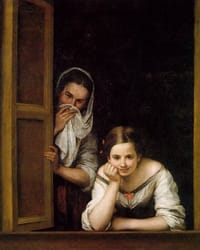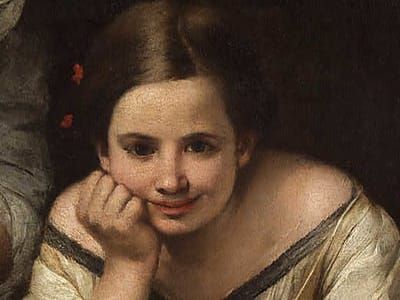

Two Women at a Windows, 1655-1660
Bartolomé Esteban Murillo
Some sites call this "A Girl And Her Duenna."
c. 1655–60
...There’s an unusual commonality in many of Murillo’s portraits: his use of a “fictive frame,” or painting a frame into the painting itself. The effect becomes ever more pronounced in his 1670 self portrait, with the artist’s hand grasping the frame into which he’s painted. And even in “Two Women at a Window,” the figures look out their window frame as if out of the painting itself.
[https://hyperallergic.com/415946/the-unsung-portraits-of-bartolome-esteban-murillo/]
...[unlike plays] painting remains. Pictures are continually open for viewing (even if the buildings they're in shut). They wait there, wallflowers, for someone to arrive and take an interest. With a picture, it's the viewer who makes the going: initiating the relationship, deciding how long it will be, whether to return.... But most pictures never close. It's you, the itinerant viewer, who sets the duration. You arrive and you stand and you leave. Indeed, one distinguishing feature of the visual arts is that they're normally experienced on foot.
Can pictures take account of your comings and goings? Mostly, they don't....
But there are pictures that do reckon with your timing. They play upon your actual arrival or departure. How? Their figures are shown reacting to a viewer whose position is more contingent - who has just turned up, or looks like leaving, or won't go, or dares to turn away. They address an inconstant viewer, whose presence and attention are provisional and variable.
Take this one. It's a street scene, though no street appears. It shows two women at an open window, looking out. The street in front of them is implied. The window is a house window, the room behind them is in cool darkness, and the light that falls on them is the high light of day. This indoor scene is predicated on the outdoor world before it. The women's looks can't be understood without imagining what they're looking at: the passing street-life in a Spanish town.
Equally, the scene is a direct interface with the viewer. The window frame corresponds closely to the edge of the picture. The women gaze out of their window straight into the gallery. The viewer's space is equated with the street. You are the passing street-life that the women have come to look at. You are the person, the man in the street, who's walking along and catching the young woman's eye.
It's a scene that reckons with an ambulant viewer. It doesn't assume that you're already there, looking. It's on the look out for you. It's lying in wait. It plays on your arrival. The young woman leans on the sill, bare-shouldered, head in hand, half-smiling, facing and staring ahead. And her gaze can be read, not as actual eye contact, but as something prior. She's watching out. She's watching someone who isn't yet looking at her. She's steadily giving the eye. And when you do approach this picture, and catch this gaze, you see it as a gaze that's been waiting for you, tracking you, inviting you, all along, before you noticed. And now it has got you.
There's a second gaze in this scene, of course. The older woman - the duenna? - standing half-behind the shutter, peeping from behind her veil, is in possible eye contact, too. Or she is, if you look at her. But in this picture, it's clear that the claims of the two gazes are unequal. The younger woman, bolder, more attractive, has priority. The older woman, poking into view, is a secondary figure. You're aware of her, in the corner of your eye, as another gaze, also aimed at you, which you could meet. But her role in the scene is specifically as an interference. She's keeping an eye on you. Her intruding, monitoring presence intensifies the intimate exchange between the younger woman and you, the man in the street.
Except that the twist is, it never gets that intimate. The expected pay-off is frustrated. You catch the young woman's gaze, and approach. From afar it seemed to offer reciprocal eye contact. But when you get close, and try to make these eyes meet yours, they won't. Close up, you encounter an inherently distant gaze. It looked promising, but you're getting nowhere.
There's a trick in the way that Murillo has painted it. The focus of the woman's two eyes won't quite resolve. There's a slight but decisive disco-ordination of the pupils. She's looking straight in your direction, but her look won't fix yours (though it always feels it might). You can see her as in a reverie, or pretended reverie. She's blurring or blanking you out. Staring through you. Waiting for your next move. She's already lost interest and is waiting for the next guy. She doesn't even see you....
[http://www.independent.co.uk/arts-entertainment/art/great-works/murillo-bartolom-esteban-two-women-at-a-window-c1655-795371.html]
Uploaded on Nov 5, 2016 by Jean Noel
Arthur
Wait what?










